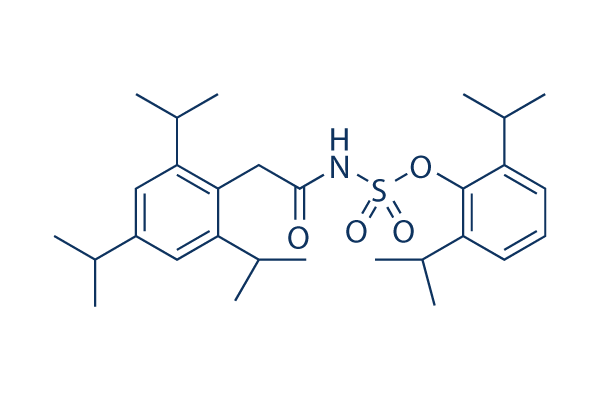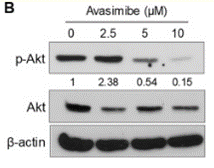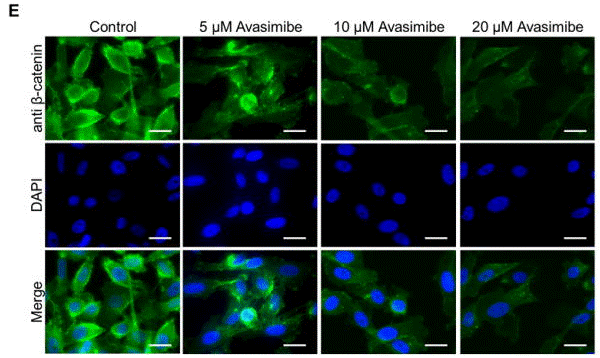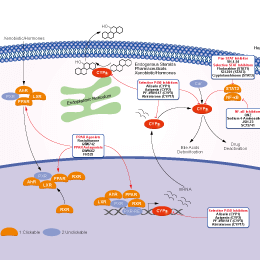
- Bioactive Compounds
- By Signaling Pathways
- PI3K/Akt/mTOR
- Epigenetics
- Methylation
- Immunology & Inflammation
- Protein Tyrosine Kinase
- Angiogenesis
- Apoptosis
- Autophagy
- ER stress & UPR
- JAK/STAT
- MAPK
- Cytoskeletal Signaling
- Cell Cycle
- TGF-beta/Smad
- Compound Libraries
- Popular Compound Libraries
- Customize Library
- Clinical and FDA-approved Related
- Bioactive Compound Libraries
- Inhibitor Related
- Natural Product Related
- Metabolism Related
- Cell Death Related
- By Signaling Pathway
- By Disease
- Anti-infection and Antiviral Related
- Neuronal and Immunology Related
- Fragment and Covalent Related
- FDA-approved Drug Library
- FDA-approved & Passed Phase I Drug Library
- Preclinical/Clinical Compound Library
- Bioactive Compound Library-I
- Bioactive Compound Library-Ⅱ
- Kinase Inhibitor Library
- Express-Pick Library
- Natural Product Library
- Human Endogenous Metabolite Compound Library
- Alkaloid Compound LibraryNew
- Angiogenesis Related compound Library
- Anti-Aging Compound Library
- Anti-alzheimer Disease Compound Library
- Antibiotics compound Library
- Anti-cancer Compound Library
- Anti-cancer Compound Library-Ⅱ
- Anti-cancer Metabolism Compound Library
- Anti-Cardiovascular Disease Compound Library
- Anti-diabetic Compound Library
- Anti-infection Compound Library
- Antioxidant Compound Library
- Anti-parasitic Compound Library
- Antiviral Compound Library
- Apoptosis Compound Library
- Autophagy Compound Library
- Calcium Channel Blocker LibraryNew
- Cambridge Cancer Compound Library
- Carbohydrate Metabolism Compound LibraryNew
- Cell Cycle compound library
- CNS-Penetrant Compound Library
- Covalent Inhibitor Library
- Cytokine Inhibitor LibraryNew
- Cytoskeletal Signaling Pathway Compound Library
- DNA Damage/DNA Repair compound Library
- Drug-like Compound Library
- Endoplasmic Reticulum Stress Compound Library
- Epigenetics Compound Library
- Exosome Secretion Related Compound LibraryNew
- FDA-approved Anticancer Drug LibraryNew
- Ferroptosis Compound Library
- Flavonoid Compound Library
- Fragment Library
- Glutamine Metabolism Compound Library
- Glycolysis Compound Library
- GPCR Compound Library
- Gut Microbial Metabolite Library
- HIF-1 Signaling Pathway Compound Library
- Highly Selective Inhibitor Library
- Histone modification compound library
- HTS Library for Drug Discovery
- Human Hormone Related Compound LibraryNew
- Human Transcription Factor Compound LibraryNew
- Immunology/Inflammation Compound Library
- Inhibitor Library
- Ion Channel Ligand Library
- JAK/STAT compound library
- Lipid Metabolism Compound LibraryNew
- Macrocyclic Compound Library
- MAPK Inhibitor Library
- Medicine Food Homology Compound Library
- Metabolism Compound Library
- Methylation Compound Library
- Mouse Metabolite Compound LibraryNew
- Natural Organic Compound Library
- Neuronal Signaling Compound Library
- NF-κB Signaling Compound Library
- Nucleoside Analogue Library
- Obesity Compound Library
- Oxidative Stress Compound LibraryNew
- Plant Extract Library
- Phenotypic Screening Library
- PI3K/Akt Inhibitor Library
- Protease Inhibitor Library
- Protein-protein Interaction Inhibitor Library
- Pyroptosis Compound Library
- Small Molecule Immuno-Oncology Compound Library
- Mitochondria-Targeted Compound LibraryNew
- Stem Cell Differentiation Compound LibraryNew
- Stem Cell Signaling Compound Library
- Natural Phenol Compound LibraryNew
- Natural Terpenoid Compound LibraryNew
- TGF-beta/Smad compound library
- Traditional Chinese Medicine Library
- Tyrosine Kinase Inhibitor Library
- Ubiquitination Compound Library
-
Cherry Picking
You can personalize your library with chemicals from within Selleck's inventory. Build the right library for your research endeavors by choosing from compounds in all of our available libraries.
Please contact us at [email protected] to customize your library.
You could select:
- Antibodies
- Bioreagents
- qPCR
- 2x SYBR Green qPCR Master Mix
- 2x SYBR Green qPCR Master Mix(Low ROX)
- 2x SYBR Green qPCR Master Mix(High ROX)
- Protein Assay
- Protein A/G Magnetic Beads for IP
- Anti-DYKDDDDK Tag magnetic beads
- Anti-DYKDDDDK Tag Affinity Gel
- Anti-Myc magnetic beads
- Anti-HA magnetic beads
- Poly DYKDDDDK Tag Peptide lyophilized powder
- Protease Inhibitor Cocktail
- Protease Inhibitor Cocktail (EDTA-Free, 100X in DMSO)
- Phosphatase Inhibitor Cocktail (2 Tubes, 100X)
- Cell Biology
- Cell Counting Kit-8 (CCK-8)
- Animal Experiment
- Mouse Direct PCR Kit (For Genotyping)
- New Products
- Contact Us
Avasimibe
Synonyms: CI-1011, PD-148515
Avasimibe inhibits ACAT with IC50 of 3.3 μM, also inhibits human P450 isoenzymes CYP2C9, CYP1A2 and CYP2C19 with IC50 of 2.9 μM, 13.9 μM and 26.5 μM, respectively.

Avasimibe Chemical Structure
CAS: 166518-60-1
Selleck's Avasimibe has been cited by 19 Publications
5 Customer Reviews
Purity & Quality Control
Batch:
Purity:
99.95%
99.95
Other P450 (e.g. CYP17) Products
Related compound libraries
Choose Selective P450 (e.g. CYP17) Inhibitors
Cell Data
| Cell Lines | Assay Type | Concentration | Incubation Time | Formulation | Activity Description | PMID |
|---|---|---|---|---|---|---|
| THP1 cells | Function assay | Inhibition of ACAT-mediated esterified cholesterol accumulation in human THP1 cells exposed to acetyl-LDL during differentiation assessed as effect on foam cell formation, IC50=1.5 μM | 18620381 | |||
| HepG2 cells | Function assay | Inhibition of ACAT in human HepG2 cells, IC50=0.479 μM | 19167888 | |||
| rat macrophages | Function assay | 24 h | Inhibition of ACAT in rat macrophages assessed as incorporation of extracellular [3H]-oleic acid-BSA complex into the intracellular cholesteryl ester after 24 hrs, IC50=0.479 μM | 19464189 | ||
| SJ-GBM2 | qHTS assay | qHTS of pediatric cancer cell lines to identify multiple opportunities for drug repurposing: Primary screen for SJ-GBM2 cells | 29435139 | |||
| BT-37 | qHTS assay | qHTS of pediatric cancer cell lines to identify multiple opportunities for drug repurposing: Primary screen for BT-37 cells | 29435139 | |||
| NB-EBc1 | qHTS assay | qHTS of pediatric cancer cell lines to identify multiple opportunities for drug repurposing: Primary screen for NB-EBc1 cells | 29435139 | |||
| Saos-2 | qHTS assay | qHTS of pediatric cancer cell lines to identify multiple opportunities for drug repurposing: Primary screen for Saos-2 cells | 29435139 | |||
| NB1643 | qHTS assay | qHTS of pediatric cancer cell lines to identify multiple opportunities for drug repurposing: Primary screen for NB1643 cells | 29435139 | |||
| OHS-50 | qHTS assay | qHTS of pediatric cancer cell lines to identify multiple opportunities for drug repurposing: Primary screen for OHS-50 cells | 29435139 | |||
| IC21 | Function assay | Inhibition of ACAT1 in mouse IC21 cells in absence of BSA, IC50=0.06μM | 29945757 | |||
| J774 | Function assay | 18 hrs | Inhibition of ACAT1 in mouse J774 cells assessed as reduction in esterified cholesterol accumulation after 18 hrs in presence of 25-hydroxycholesterol, IC50=0.59μM | 29945757 | ||
| IC21 | Function assay | Inhibition of ACAT1 in mouse IC21 cells in presence of BSA, IC50=0.76μM | 29945757 | |||
| Caco-2 | Function assay | 48 hrs | Determination of IC50 values for inhibition of SARS-CoV-2 induced cytotoxicity of Caco-2 cells after 48 hours by high content imaging, IC50=3.93μM | ChEMBL | ||
| Caco-2 | Toxicity assay | 48 hrs | Toxicity against Caco-2 cells determined at 48 hours by intracellular ATP concentration using the CellTiter-Glo Luminescent Cell Viability Assay, CC50=13.71μM | ChEMBL | ||
| Click to View More Cell Line Experimental Data | ||||||
Biological Activity
| Description | Avasimibe inhibits ACAT with IC50 of 3.3 μM, also inhibits human P450 isoenzymes CYP2C9, CYP1A2 and CYP2C19 with IC50 of 2.9 μM, 13.9 μM and 26.5 μM, respectively. | ||||||||
|---|---|---|---|---|---|---|---|---|---|
| Targets |
|
| In vitro | ||||
| In vitro | Avasimibe at concentration of 1μg/mL causes reduction of Total cholesterol (TC) and Esterified cholesterol (EC) through inhibiting LDL binding and decreasing scavenger receptor numbers during foam cell formation in human monocyte-derived macrophages (HMMs). Avasimibe at concentration of 2μg/mL enhances cholesterol efflux from established HMM foam cells preincubating with 10μg/ml LDL. [1] Avasimibe inhibits Lipoprotein(a) accumulation in the culture media of primary monkey hepatocyte in a dose-dependent manner with 11.9% -31.3% inhibition, the change is mainly associated with decreased ApoA. [2] Avasimibe incubating at concentration of 10 nM, 1 μM, and 10 μM for 24 hours in HepG2 cells reduce ApoB secretion into media by 25%, 27%, and 43%, respectively. Avasimibe decreases ApoB secretion by enhanced intracellular degradation of ApoB rather than decreased synthesis of ApoB. [3] Avasimibe inhibits ACTC with IC50 of 3.3 μM in IC-21 macrophages with consideration of the total inhibitor concentration in the assay sample. [4] Avasimibe inhibits human P450 isoenzymes CYP2C9, CYP1A2 and CYP2C19 with IC50 of 2.9 μM, 13.9 μM and 26.5 μM, respectively. [5] Avasimibe inhibits ACAT-1 expression and cholesterol ester synthesis in glioma cell lines. Avasimibe inhibits the growth of the glioma cells by inducing cell cycle arrest and apoptosis due to caspase-8 and caspase-3 activation. [6] | |||
|---|---|---|---|---|
| Kinase Assay | P450 Inhibition Studies | |||
| Pooled human liver microsomes (HLM) from at least 15 donors are used for all inhibition assays. For IC50 determinations, the substrate probes are used at their approximate in vitro Km values. All incubations are performed with 100 mM potassium phosphate buffer (pH 7.4) and 1 mM NADPH. For CYP1A2 inhibition study, incubations are performed in a total volume of 0.5 ml, in duplicates with 0.1 mg/ml HLM, 30 μM phenacetin, 1 mM NADPH, and in the presence of avasimibe (0, 0.3, 0.75, 1.5, 3, 7.5, 15, 30, and 40 μM in 50 mM) in a potassium phosphate buffer at pH 7.4. After preincubation at 37 °C for 7 min, NADPH is added to initiate the enzyme reaction. The reaction mixture is quenched with 500 μl of ice-cold 100 ng/ml paracetamol-D4/CH3CN after 25 min. The standards (4-acetamidophenol, singlet) and quality controls (triplicates for low, medium, and high) are prepared at room temperature. After mixing, 0.2 ml of the samples is transferred to another plate and submitted for LC/MS/MS analysis after centrifugation at 3000 rpm for 10 min. A Supelco Discovery Amide C16, 100 × 2.1 mm (5-μm particle size) column (Supelco, Bellefonte, PA) is used. The mobile phase is isocratic, 40:60 [acetonitrile/formic acid, 0.1% (v/v)] at 0.2 ml/min. | ||||
| Cell Research | Cell lines | primary human monocyte-derived macrophages | ||
| Concentrations | 1 μg/mL or 2 μg/mL | |||
| Incubation Time | 48 hours | |||
| Method | For foam cell formation, the growth medium (RPMI medium containing 10% human serum) is aspirated and the BMMs are rinsed four times with RPMI medium, and then HMMs are exposed to RPMI medium containing bovine serum albumin (BSA, 0.2%) and dimethylsulfoxide (DMSO, 0.2%, vehicle for CI-1011) (control medium) with and without agacLDL (100 μg protein/ml) and CI-1011 (1 μg/ml) for 48 hours. For cholesterol efflux experiments, HMMs are preincubated with ag-acLDL (100 μg protein/ml) for 24h, and then exposed to control RPMI medium with and without HDL (100 μg protein/ml), CI-1011 (2 μg/ml) or HDL plus CI-1011 (2 μg/ml) for 24–48 hours. Additionally, the appearance of [14C]FC in the medium is monitored by first preincubating HMMs with RPMI medium containing ag-acLDL (100 μg protein/ml) radiolabeled with [4-14C]FC (0.5 μCi/ml) in an ethanolic spritz (final concentration, 0.1%) for 24 h. The medium is removed, cells rinsed three times with RPMI medium, and then cells are exposed to control RPMI medium with and without CI-1011 (1–10 μg/ml) for 4–48 h. At each time point, the medium is aspirated and centrifuged to pellet nonadherent cells. The appearance of [14C]FC in the medium is measured by liquid scintillation spectroscopy. Cellular lipids are extracted using hexane:isopropanol (3:2, v/v) for 1 h. The distribution of cellular radiolabeled cholesterol is measured by subjecting an aliquot of the cell extract and FC and EC standards to thin layer chromatography using petroleum ether:hexane:glacial acetic acid solvent system (85:15:2, v/v). The percent FC efflux is calculated as: medium [14C]FC dpm/ cell [14C] dpm×100. FC and TC mass are quantified by gas liquid chromatography using stigmasterol (1 mg/ml) as an internal standard. EC mass is calculated as the difference between TC and FC, and all values are normalized to cell protein. The MBC is defined as the lowest concentration that exhibited 99.9% or more reduction of the numbers of colonies compared with the cfu in the initial inoculum. |
|||
| Experimental Result Images | Methods | Biomarkers | Images | PMID |
| Western blot | p-AKT / AKT Active β-catenin |

|
29489864 | |
| Immunofluorescence | β-catenin |

|
29545473 | |
| In Vivo | ||
| In vivo | Avasimibe significantly reduces Lipoprotein(a) and total cholesterol levels in nine healthy male monkeys with a normal chow diet orally treated with CI-1011 at 30 mg/kg per day for 3 weeks, Lipoprotein(a) and total cholesterol levels reduce to 68 and 73% of control levels, respectively. Avasimibe decreases total cholesterol mainly due to reduction of low density lipoprotein (LDL). [2] Avasimibe decreases amyloid plaque load in the cortex and hippocampus and reduces the levels of insoluble Abeta40 and Abeta42 and C-terminal fragments of amyloid precursor protein (APP) in brain extracts in young human APP transgenic mice. Avasimibe reduces diffuse amyloid plaques by suppression of astrogliosis and enhanced microglial activation in aged human APP transgenic mice. [7] | |
|---|---|---|
| Animal Research | Animal Models | male cynomolgus monkeys |
| Dosages | 30 mg/kg | |
| Administration | Orally at a single dose per day for 3 weeks | |
Chemical lnformation & Solubility
| Molecular Weight | 501.72 | Formula | C29H43NO4S |
| CAS No. | 166518-60-1 | SDF | Download Avasimibe SDF |
| Smiles | CC(C)C1=C(C(=CC=C1)C(C)C)OS(=O)(=O)NC(=O)CC2=C(C=C(C=C2C(C)C)C(C)C)C(C)C | ||
| Storage (From the date of receipt) | |||
|
In vitro |
DMSO : 100 mg/mL ( (199.31 mM); Warmed with 50°C water bath; Ultrasonicated; Moisture-absorbing DMSO reduces solubility. Please use fresh DMSO.) Ethanol : 16 mg/mL Water : Insoluble |
Molecular Weight Calculator |
|
In vivo Add solvents to the product individually and in order. |
In vivo Formulation Calculator |
||||
Preparing Stock Solutions
Molarity Calculator
In vivo Formulation Calculator (Clear solution)
Step 1: Enter information below (Recommended: An additional animal making an allowance for loss during the experiment)
mg/kg
g
μL
Step 2: Enter the in vivo formulation (This is only the calculator, not formulation. Please contact us first if there is no in vivo formulation at the solubility Section.)
% DMSO
%
% Tween 80
% ddH2O
%DMSO
%
Calculation results:
Working concentration: mg/ml;
Method for preparing DMSO master liquid: mg drug pre-dissolved in μL DMSO ( Master liquid concentration mg/mL, Please contact us first if the concentration exceeds the DMSO solubility of the batch of drug. )
Method for preparing in vivo formulation: Take μL DMSO master liquid, next addμL PEG300, mix and clarify, next addμL Tween 80, mix and clarify, next add μL ddH2O, mix and clarify.
Method for preparing in vivo formulation: Take μL DMSO master liquid, next add μL Corn oil, mix and clarify.
Note: 1. Please make sure the liquid is clear before adding the next solvent.
2. Be sure to add the solvent(s) in order. You must ensure that the solution obtained, in the previous addition, is a clear solution before proceeding to add the next solvent. Physical methods such
as vortex, ultrasound or hot water bath can be used to aid dissolving.
Tech Support
Answers to questions you may have can be found in the inhibitor handling instructions. Topics include how to prepare stock solutions, how to store inhibitors, and issues that need special attention for cell-based assays and animal experiments.
Tel: +1-832-582-8158 Ext:3
If you have any other enquiries, please leave a message.
* Indicates a Required Field
Frequently Asked Questions
Question 1:
I'd like to have more information about the in vivo administration of avasimibe in monkeys?
Answer:
S2187 can be dissolved in 2% DMSO+corn oil at 5mg/ml clearly, and in 0.5% CMC Na+1% Tween 80 at 10mg/ml as a suspension.
Question 2:
We want to use it for mice study by IP injection. I was wondering if you have any suggestions how to make a soluble solution for IP injection?
Answer:
S2187 Avasimibe can be dissolved in 5% DMSO+30% PEG 300+5% Tween 80+ddH2O at 1 mg/ml as a clear solution. When preparing the solution, please dissolve the compound in DMSO clearly first, then add PEG and Tween. After they mixed well, then dilute with water. And we found after stayed for about 20min, the precipitation will go out. So please prepare the solution just before use.
Tags: buy Avasimibe | Avasimibe supplier | purchase Avasimibe | Avasimibe cost | Avasimibe manufacturer | order Avasimibe | Avasimibe distributor








































